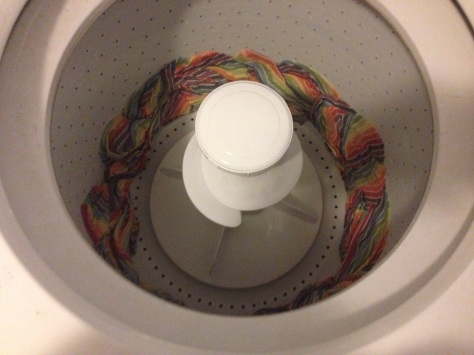I happen to only own cotton wraps (for now!) so the process is pretty easy for me. Be aware, however, that different fibers require different care and washing/drying methods.
Today I wrapped my Girasol Avalon Diamond Weave size 5 woven wrap. I’ve been practicing a ton lately with Atticus and he gets an m&ms as a treat when he cooperates. He’s been doing really well…. But there’ve been a few times when I’ve ended up with chocolate in my hair and on the wrap. It’s been in need of a good washing!
Washing
I threw the wrap into the washing machine on a gentle cycle with a small linen bag of soap nuts. Soap nuts are a natural way to wash things and I love them. I washed the Avalon solo because I don’t want it to get twisted up with anything else.
After it was finished washing I let it set for a few minutes to let any leftover water drip off, then I checked it over to make sure all the grime came out and to check for any pulls or loose threads. All clear!
Drying
Here you have some options… I like to use the drying process as a way to beat my wraps into submission, plus I’m impatient, so I toss the wrap in the dryer on a low-heat cycle. I add my three Woolzies dryer balls to help break the wrap in. These natural wool dryer balls work as a fabric softener and also speed up the drying time.
Cotton things can shrink, though… So if you’re concerned you can also hang dry your wrap. The best option is, of course, using an outdoor clothes line… the sun makes it smell wonderful and frankly if you have access to a clothes line you should just always take advantage of it (we aren’t allowed them in my neighborhood, can ya tell I’m bitter?). If it’s rainy, cold, or you just don’t have an outdoor clothes line, you can also hang the wrap to dry in your shower or in your laundry room. Use hangers to loop the wrap accordion- style (see below) and just leave it be for awhile.
And you’re done! Now it’s time to snuggle, hammock, or wrap with your woven 🙂
More Info
A few things…
•Be careful with your wrap and always check for pulls, loose threads, etc. before washing, between washing and drying, and after drying
•Do NOT use fabric softener or other scented washing accessories
•If you’re washing a ringsling wrap a sock or something around the rings when drying
•If you’re just wanting to break in your wrap there are other options, so don’t feel limited to washing
•If you’re not sure or insecure about washing, ask! Post on a forum or Facebook group or check the following resources:
–Paxbaby washing instructions
–Babywearing 102 washing and care
















